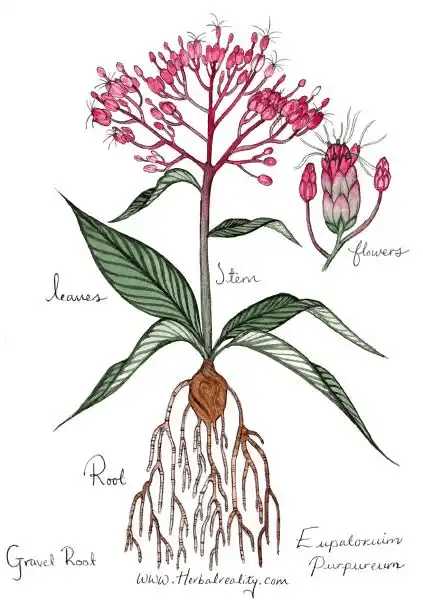Gravel Root, scientifically known as Eupatorium purpureum, is a perennial herbaceous plant native to North America. Also commonly referred to as Joe-Pye weed, kidney root, or trumpet weed, this plant belongs to the Asteraceae family and is known for its tall, robust stems, and clusters of pink to purple flowers.
Key features of Gravel Root include its whorled leaves arranged in groups of three to seven along the stem and its large, domed flower heads that attract pollinators such as butterflies and bees. The plant typically blooms in late summer to early fall, adding a burst of color to wet meadows, stream banks, and other moist habitats where it thrives.
Historically, Native American tribes and early European settlers utilized Gravel Root for various medicinal purposes. The plant’s common name “Joe-Pye weed” is thought to have originated from a Native American healer named Joe Pye, who reportedly used the plant to treat fevers.
Traditionally, Gravel Root has been employed in herbal remedies for conditions such as kidney stones, urinary issues, and rheumatism.
In terms of its potential medicinal properties, Gravel Root is believed to contain compounds such as flavonoids, sesquiterpene lactones, and volatile oils.
However, it’s important to note that scientific research on the efficacy and safety of Gravel Root is limited, and its use as a medicinal herb should be approached with caution. As with any herbal remedy, it is advisable to consult with a healthcare professional before using Gravel Root, especially if you have underlying health conditions or are taking medications.
In landscaping, Gravel Root is valued for its ornamental qualities and its ability to attract pollinators. It is often used in naturalistic or wildflower gardens, particularly in locations with moist or wet soil.
The plant’s tolerance for wet conditions makes it suitable for rain gardens and areas with poor drainage.
Cultivating Gravel Root typically requires moist to wet soil and partial to full sunlight. The plant can be a great addition to gardens designed to support pollinators and create a naturalistic, native plant habitat.
Eupatorium purpureum, or Gravel Root, is a plant with historical significance in traditional medicine and ornamental value in landscaping.
While its traditional uses are noted, caution is advised, and consultation with a healthcare professional is recommended before considering it for medicinal purposes.
In natural settings and gardens alike, Gravel Root contributes to biodiversity and adds beauty to the landscape with its attractive flowers.
The Botanical Description of Gravel Root
1. Overview: Gravel root, scientifically known as Eupatorium purpureum, is a perennial herbaceous plant that belongs to the Asteraceae family. It is renowned for its striking appearance and various medicinal properties.
2. Height and Structure: Gravel root typically grows to a height of 3 to 4 feet, with a sturdy and upright stem. The stem is square-shaped, a distinctive characteristic of the plant, and it is often branched.
3. Leaves and Flowers: The leaves of gravel root are opposite, lance-shaped, and serrated, showcasing vibrant green hues during the growing season. When in bloom, the plant produces dense clusters of tiny, purple-pink flowers, creating an attractive floral display.
4. Root System: Below the soil surface, gravel root develops a robust and fibrous root system. The roots are the part of the plant traditionally utilized for medicinal purposes.
5. Preferred Habitat: Gravel root thrives in moist to wet environments and is commonly found along riverbanks, stream edges, and in damp meadows. Its affinity for water-rich habitats contributes to its resilience in various ecosystems.
The Geographic Distribution of Gravel Root
1. Native Regions: Gravel root is native to North America and is prevalent in the eastern and central parts of the continent. It can be found from Canada to the southern regions of the United States.
2. Global Presence: Due to its adaptability, gravel root has been introduced to other parts of the world, including Europe. However, its primary distribution remains concentrated in its native North American regions.
3. Habitat Preferences: Gravel root displays a preference for riparian zones and areas with consistent moisture. It is often part of the vegetation lining water bodies, contributing to the biodiversity of these ecosystems.
4. Cultivation in Gardens: Beyond its native habitat, gravel root is cultivated in gardens for its aesthetic appeal and potential medicinal use. Gardeners appreciate its ability to attract pollinators and its role in landscaping.
The Chemical Composition of Gravel Root
1. Active Compounds: Gravel root contains a diverse array of bioactive compounds, including flavonoids, tannins, volatile oils, and sesquiterpene lactones. These constituents contribute to the plant’s medicinal properties.
2. Anti-Inflammatory Agents: The presence of sesquiterpene lactones in gravel root imparts anti-inflammatory effects, making it a potential remedy for conditions involving inflammation.
3. Diuretic Properties: Gravel root is recognized for its diuretic properties, attributed to certain compounds that promote increased urine production. This aspect is of interest in traditional medicine for addressing urinary issues.
4. Immunostimulant Effects: Some compounds in gravel root may have immunostimulant effects, influencing and enhancing the activity of the immune system.
5. Analgesic Qualities: Gravel root is believed to possess analgesic qualities, potentially providing relief from pain and discomfort. This aspect is under ongoing scientific investigation.
6. Anti-Rheumatic Potential: Due to its anti-inflammatory properties, gravel root is explored for its potential in managing rheumatic conditions, where inflammation plays a key role.
7. Anti-spasmodic Actions: Certain compounds in gravel root may exhibit anti-spasmodic effects, contributing to its traditional use in alleviating muscle spasms and cramps.
8. Antioxidant Benefits: The flavonoids and other antioxidants in gravel root contribute to its ability to combat oxidative stress, protecting cells from damage caused by free radicals.
9. Traditional Uses: Gravel root has a history of traditional use by Native American tribes for various purposes, including addressing urinary tract issues, kidney health, and women’s health.
10. Toxicological Considerations: While generally considered safe when used as directed, it’s essential to exercise caution and consult healthcare professionals, as excessive consumption may lead to adverse effects. Proper dosage and usage guidance are crucial for safety.
Read Also: 18 Medicinal Health Benefits Of Stone Root (Collinsonia canadensis)
The Medicinal Health Benefits Of Gravel Root (Eupatorium purpureum)

1. Anti-Inflammatory Properties: Gravel root is recognized for its potent anti-inflammatory effects, making it beneficial for individuals dealing with inflammatory conditions such as arthritis and joint pain.
2. Diuretic Action: The diuretic properties of gravel root promote increased urine production, aiding in the elimination of toxins from the body and supporting kidney health.
3. Urinary Tract Health: Gravel root has been traditionally used to address urinary tract issues, including infections and discomfort, thanks to its potential antimicrobial properties.
4. Pain Relief: The analgesic qualities of gravel root contribute to its effectiveness in providing relief from various types of pain, making it a valuable natural remedy.
5. Immune System Support: Certain compounds in gravel root may have immunostimulant effects, enhancing the activity of the immune system and promoting overall health.
6. Antioxidant Benefits: Gravel root is rich in antioxidants, helping combat oxidative stress and protect cells from damage caused by free radicals.
7. Anti-Spasmodic Actions: Gravel root’s anti-spasmodic effects make it beneficial for alleviating muscle spasms and cramps, providing comfort to individuals experiencing such issues.
8. Women’s Health: Traditionally used for women’s health, gravel root may offer relief from menstrual discomfort and support overall reproductive health.
9. Respiratory Health: Gravel root’s anti-inflammatory properties extend to respiratory health, making it a potential remedy for conditions like bronchitis and coughs.
10. Cardiovascular Support: Some studies suggest that gravel root may have cardiovascular benefits, including potential positive effects on heart health.
The Methods of Usage to Achieve the Provided Health Benefits Of Gravel Root (Eupatorium purpureum)
1. Herbal Tea Infusion: Brewing gravel root as an herbal tea allows for easy consumption and absorption of its medicinal compounds. This is a common and traditional method of usage.
2. Tinctures and Extracts: Liquid extracts, such as tinctures, provide a concentrated form of gravel root, offering a convenient and measured way to incorporate its benefits into daily routines.
3. Capsules or Tablets: Gravel root supplements in capsule or tablet form provide a controlled dosage for those who prefer a more straightforward method of consumption.
4. Poultices: Creating a poultice with crushed or powdered gravel root for topical application can be effective in addressing localized pain, inflammation, or skin conditions.
5. Decoctions: Boiling gravel root to create a decoction allows for a more potent liquid, suitable for addressing specific health concerns, especially those related to the urinary tract.
6. Steam Inhalation: Inhaling steam infused with gravel root can provide respiratory benefits, making it a suitable method for addressing issues like coughs and bronchitis.
7. Bath Additive: Adding gravel root to a bath can offer a soothing and relaxing experience, potentially providing benefits for overall well-being.
8. Syrups: Gravel root syrups, often sweetened for palatability, provide another option for easy consumption, particularly for those who prefer a more pleasant taste.
9. Salves and Ointments: Topical application of gravel root in the form of salves or ointments can be beneficial for addressing skin conditions or providing localized pain relief.
10. Culinary Uses: In some cultures, gravel root is incorporated into culinary creations, although its usage for medicinal benefits is more commonly associated with specific preparations mentioned above.
The Side Effects Of Using Gravel Root Medicinal Plant
1. Allergic Reactions: Some individuals may experience allergic reactions to gravel root, especially those with known allergies to the Asteraceae family.
2. Digestive Upset: Excessive consumption of gravel root may lead to digestive discomfort, nausea, or vomiting in some individuals.
3. Pregnancy and Breastfeeding: Pregnant and breastfeeding individuals should exercise caution and consult healthcare providers before using gravel root due to potential effects on reproductive health.
4. Liver Conditions: Individuals with pre-existing liver conditions should exercise caution, as gravel root may have potential effects on liver function.
5. Interaction with Medications: Gravel root may interact with certain medications, particularly those metabolized by the liver. Consultation with a healthcare professional is advised.
6. Not for Prolonged Use: Gravel root is not recommended for prolonged use, and extended usage should be monitored and guided by healthcare professionals.
7. Children and Elderly: Special caution is advised for children and the elderly, and usage should be under the guidance of healthcare professionals.
8. Discontinuation of Use: If any adverse effects occur, it’s crucial to discontinue the use of gravel root and seek medical attention promptly.
9. Professional Guidance: Before incorporating gravel root into any health regimen, consulting with healthcare professionals is advisable, especially for individuals with pre-existing medical conditions.
10. Quality of Source: Ensuring the quality and purity of gravel root products is essential, as contaminants or impurities may pose additional risks. Obtaining gravel root from reputable sources is recommended for safety and efficacy.
Read Also: How to Grow and Care for Brassicas
The Scientific Research and Studies of Gravel Root (Eupatorium purpureum)

1. Antimicrobial Properties: Scientific research has delved into the antimicrobial properties of gravel root, revealing its potential in inhibiting the growth of certain microorganisms. These findings contribute to its traditional use in addressing urinary tract issues.
2. Anti-Inflammatory Effects: Numerous studies have explored the anti-inflammatory effects of gravel root, highlighting its capacity to modulate inflammatory pathways. This aspect is particularly valuable for conditions involving inflammation, such as arthritis.
3. Diuretic Action: Scientific investigations have focused on the diuretic action of gravel root, providing insights into its impact on increasing urine production. This property is crucial for kidney health and addressing urinary concerns.
4. Analgesic Qualities: Research suggests that gravel root may possess analgesic qualities, indicating its potential for pain relief. This aspect is of interest for individuals seeking natural alternatives for managing pain.
5. Immunomodulatory Effects: Studies have examined the immunomodulatory effects of gravel root, shedding light on its ability to modulate and enhance immune system responses. This property contributes to its overall health-supporting benefits.
6. Potential Cardiovascular Benefits: Preliminary research has explored potential cardiovascular benefits associated with gravel root. While findings are still emerging, there is interest in its role in supporting heart health.
7. Anti-Spasmodic Actions: Scientific research has investigated the anti-spasmodic actions of gravel root, particularly in relation to muscle spasms and cramps. This property adds to the plant’s versatility in addressing various health concerns.
8. Antioxidant Activity: Gravel root’s antioxidant activity has been a subject of scientific scrutiny, revealing its capacity to neutralize free radicals and protect cells from oxidative damage. This aspect contributes to its overall health-promoting effects.
9. Anti-Cancer Research: While in early stages, there is ongoing research exploring the potential anti-cancer properties of gravel root. This area of study aims to understand its role in cancer prevention and treatment.
10. Safety and Toxicology: Scientific studies have addressed the safety and toxicology of gravel root, providing crucial information on appropriate dosages and potential adverse effects. This research guides healthcare professionals and individuals in its safe use.
The Safety Precautions and Recommendations In Using Gravel Root (Eupatorium purpureum) Medicinal Plant
1. Dosage and Duration: Adhering to recommended dosages and durations is crucial to prevent potential adverse effects associated with excessive intake of gravel root. Consultation with healthcare professionals is advised, especially for prolonged use.
2. Allergic Reactions: Individuals with known allergies to the Asteraceae family, which includes gravel root, should exercise caution, as allergic reactions are possible. It’s essential to perform a patch test before widespread use.
3. Pregnancy and Breastfeeding: Pregnant and breastfeeding individuals should consult healthcare providers before using gravel root due to potential effects on reproductive health. Limited safety data warrant caution in these populations.
4. Liver Conditions: Individuals with pre-existing liver conditions should exercise caution, as gravel root may have potential effects on liver function. Professional guidance is crucial for those with compromised liver health.
5. Interaction with Medications: Gravel root may interact with certain medications, particularly those metabolized by the liver. Informing healthcare providers about all medications being taken is essential to avoid potential complications.
6. Not for Prolonged Use: Gravel root is not recommended for prolonged use, and extended usage should be monitored and guided by healthcare professionals. Regular assessments of health status are advisable.
7. Children and Elderly: Special caution is advised for children and the elderly, and usage should be under the guidance of healthcare professionals. Adjusting dosages based on age and individual health factors is essential.
8. Discontinuation of Use: If any adverse effects occur, it’s crucial to discontinue the use of gravel root and seek medical attention promptly. Monitoring for any unexpected reactions is imperative for user safety.
9. Professional Guidance: Before incorporating gravel root into any health regimen, consulting with healthcare professionals is advisable, especially for individuals with pre-existing medical conditions. Professional guidance ensures safe and effective usage.
10. Quality of Source: Ensuring the quality and purity of gravel root products is essential, as contaminants or impurities may pose additional risks. Obtaining gravel root from reputable sources is recommended for safety and efficacy.
FAQs About Gravel Root (Eupatorium purpureum) Medicinal Plant
1. Is Gravel Root Safe for Daily Use?
While gravel root is generally considered safe when used appropriately, it’s advisable to follow recommended dosages and durations to prevent potential adverse effects.
2. Can Gravel Root Interact with Blood Pressure Medications?
Yes, gravel root may interact with certain medications. It’s crucial to inform healthcare providers about all medications being taken to avoid potential complications.
3. Is Gravel Root Safe for Pregnant Women?
Pregnant individuals should consult healthcare providers before using gravel root due to potential effects on reproductive health and limited safety data in this population.
4. Can Gravel Root Be Used for Respiratory Conditions?
Yes, gravel root has been traditionally used for respiratory conditions like bronchitis and coughs due to its anti-inflammatory and expectorant properties. However, professional advice is recommended.
5. Are There Any Known Allergic Reactions to Gravel Root?
Some individuals may experience allergic reactions, especially if they have known allergies to the Asteraceae family. A patch test is advisable before widespread use.
6. How Long Does it Take to See Results in Medicinal Applications?
Results may vary depending on the individual and the specific health condition. Consistent use and patience are advised for optimal outcomes.
7. Can Gravel Root Be Used Topically for Wound Healing?
Yes, gravel root has been traditionally used topically for wound healing. However, proper application and dilution guidelines should be followed.
8. Is Gravel Root Legal to Cultivate and Use?
Legal status may vary by region. Check local regulations before cultivating or using gravel root for medicinal purposes.
9. Can Gravel Root Be Used Alongside Other Herbal Remedies?
While it’s generally safe, it’s advisable to consult with healthcare providers when combining gravel root with other herbal remedies to avoid potential interactions.
10. What Precautions Should Be Taken for Individuals with Liver Conditions?
Individuals with liver conditions should exercise caution and consult healthcare providers before using gravel root due to potential effects on liver function.
Read Also: What You Need to Know About Osteospermum

